I first became familiar with the Battlefront games around 2005 or 2006, when the first game titled Battlefront II was put out by LucasArts and Pandemic Studios. It featured a story mode where you played as one of many nameless clone troopers during the events of Episode III: Revenge of the Sith (which had just come out) and then through the years as a stormtrooper during the events of Episodes IV and V. The game's story was fantastic (and I will cover it in segments in future posts), but its main purpose was as an arena game for both single player and multiplayer fun. I never once connected the game to the internet to play online, but I had as much fun with the "Conquest" mode (defeating your enemies on arena maps of each planet in the game plus several bonus worlds) as I had with the story mode. I later picked up the first Battlefront game (from 2004), which had no story and was less fun.
In late 2015, under the New Canon, Electronic Arts and Digital Illusions CE released their own version of Battlefront. Like the original, it had no story, but offered players online the chance to battle across maps from different planets in the movies, especially those from the original trilogy of movies.
As happened a decade ago, the sequel to Battlefront had a story mode as well as multiplayer modes. Furthermore. a pair of novels tied into Battlefront games were released, which I'm covering in this post.
For this post, I consumed the following stories:
The original Battlefront game did not have a story mode. Gameplay was based around battles between Rebel and Imperial forces, including many of the battles seen in the movies (Hoth from Episode V and Endor from Episode VI being the most notable). Later downloadable content added new battles, including the Battle of Jakku (which I wrote about in my coverage of the Aftermath books) and the Battle of Scarif (which I wrote about in my recent Rogue One post).
Battlefront: Twilight Company was a standalone story centering around an entirely new unit: the Rebel Alliance's 61st Mobile Infantry aka Twilight Company. The protagonist is Hashram Namir, who grew up on a planet that was constantly at war with itself, new warlords cropping up every few years to depose old ones, their soldiers signing onto new armies as their old ones are disbanded. The Rebels arrive at this planet and take Namir in. Twilight Company travels the Galaxy on the order of Alliance High Command, fighting off the Empire planet to planet and holding open recruitment drives wherever they liberate.
Eventually, Twilight Company recovers Everi Chalis, a disgraced Imperial governor. She understands the Imperial machine and wants to help take it apart. Namir and Chalis end up on Hoth at the time of the Empire's attack, but survive and manage to return to their ship. Having lost contact with Rebel command, they come up with a plan to severely damage the Empire's ability to field ships.
The game Battlefront II did have a story mode, which centers on the player character Iden Versio. The game is preceded by the novel Battlefront II: Inferno Squad, which details the first missions of the titular Inferno Squad. Under the oversight of Iden's father, Admiral Garrick Versio, Iden and her team must take out a number of threats to the Empire, the biggest being from the survivors of Saw Gererra's Partisans, who have evolved into a group of suicidal extremists.
The Battlefront II game picks up days before the Battle of Endor in Episode VI and continues from there. Iden and Inferno Squad are present at Endor and watch the second Death Star explode. The Squad's loyalties are divided when Admiral Versio launches Operation: Cinder (in which Imperial forces attempt to ruin their own worlds, in part to keep them from the Empire's enemies, in part because an Empire that does not protect its leader does not deserve to live). Iden and some of her squadmates join the New Republic, while others go into hiding with the Empire. The story also has segments where you play as Luke Skywalker, Han Solo, Princess Leia, Lando Calrissian, and in the epilogue Kylo Ren.
The Resurrection DLC begins during the events of The Force Awakens and focusses on Iden and her daughter Zay as they uncover significant information about the First Order, including its fleet size, technical diagrams to their Dreadnought, and the fact that they get their stormtroopers by kidnapping and brainwashing children.
Follow @C_Andrew_H
In late 2015, under the New Canon, Electronic Arts and Digital Illusions CE released their own version of Battlefront. Like the original, it had no story, but offered players online the chance to battle across maps from different planets in the movies, especially those from the original trilogy of movies.
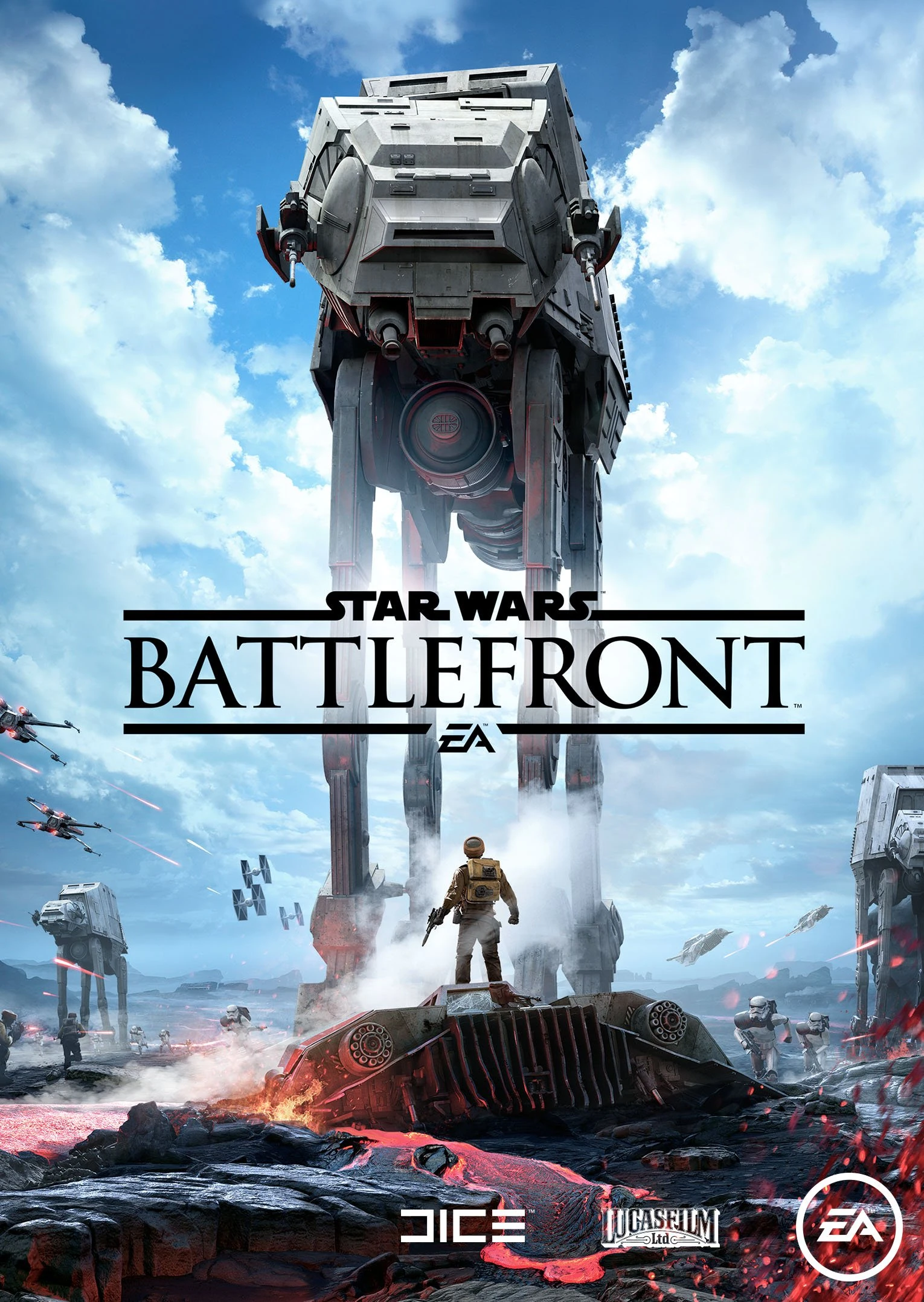 |
| Box art for Battlefront. Image from Wookieepedia. |
For this post, I consumed the following stories:
- Battlefront: Twilight Company (novel by Alexander Freed, 2015)
- Battlefront II: Inferno Squad (novel by Christie Golden, 2017)
- Battlefront II (video game by Electronic Arts Digital Illusions CE (EA DICE), Motive Studios, and Criterion Games, 2017)
- Battlefront II: Resurrection (downloadable content for the video game by EA DICE, Motive Studios, and Criterion Games,
I read both novels in hardcover format. I did not play Battlefront II, but instead watched a video of the story mode, and another one of the DLC.
Story:
The original Battlefront game did not have a story mode. Gameplay was based around battles between Rebel and Imperial forces, including many of the battles seen in the movies (Hoth from Episode V and Endor from Episode VI being the most notable). Later downloadable content added new battles, including the Battle of Jakku (which I wrote about in my coverage of the Aftermath books) and the Battle of Scarif (which I wrote about in my recent Rogue One post).Battlefront: Twilight Company was a standalone story centering around an entirely new unit: the Rebel Alliance's 61st Mobile Infantry aka Twilight Company. The protagonist is Hashram Namir, who grew up on a planet that was constantly at war with itself, new warlords cropping up every few years to depose old ones, their soldiers signing onto new armies as their old ones are disbanded. The Rebels arrive at this planet and take Namir in. Twilight Company travels the Galaxy on the order of Alliance High Command, fighting off the Empire planet to planet and holding open recruitment drives wherever they liberate.
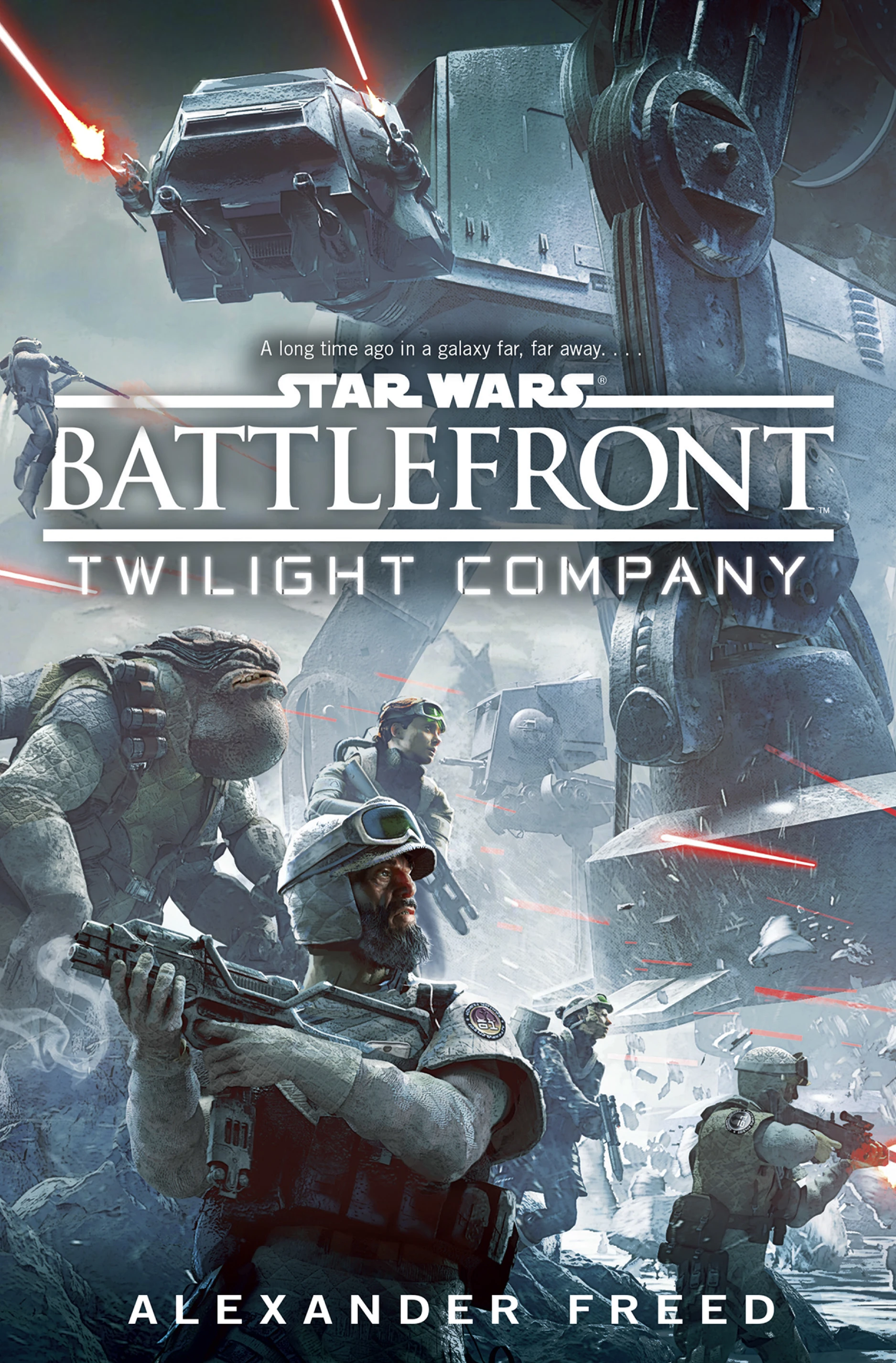 |
| Cover of Battlefront: Twilight Company by Alexander Freed. Image from Wookieepedia. |
Eventually, Twilight Company recovers Everi Chalis, a disgraced Imperial governor. She understands the Imperial machine and wants to help take it apart. Namir and Chalis end up on Hoth at the time of the Empire's attack, but survive and manage to return to their ship. Having lost contact with Rebel command, they come up with a plan to severely damage the Empire's ability to field ships.
The game Battlefront II did have a story mode, which centers on the player character Iden Versio. The game is preceded by the novel Battlefront II: Inferno Squad, which details the first missions of the titular Inferno Squad. Under the oversight of Iden's father, Admiral Garrick Versio, Iden and her team must take out a number of threats to the Empire, the biggest being from the survivors of Saw Gererra's Partisans, who have evolved into a group of suicidal extremists.
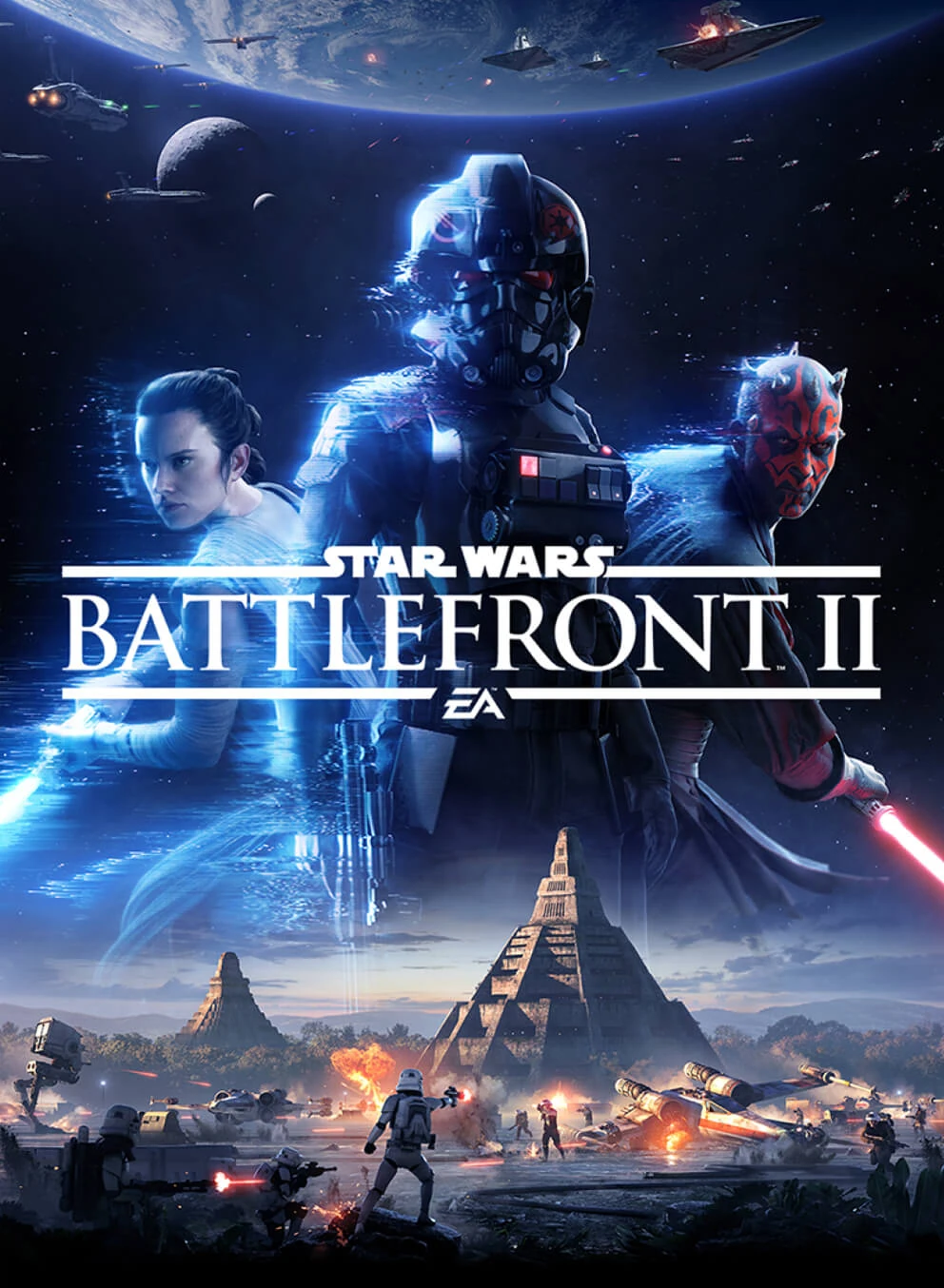 |
| Box art for Battlefront II. Image from Wookieepedia. |
The Battlefront II game picks up days before the Battle of Endor in Episode VI and continues from there. Iden and Inferno Squad are present at Endor and watch the second Death Star explode. The Squad's loyalties are divided when Admiral Versio launches Operation: Cinder (in which Imperial forces attempt to ruin their own worlds, in part to keep them from the Empire's enemies, in part because an Empire that does not protect its leader does not deserve to live). Iden and some of her squadmates join the New Republic, while others go into hiding with the Empire. The story also has segments where you play as Luke Skywalker, Han Solo, Princess Leia, Lando Calrissian, and in the epilogue Kylo Ren.
The Resurrection DLC begins during the events of The Force Awakens and focusses on Iden and her daughter Zay as they uncover significant information about the First Order, including its fleet size, technical diagrams to their Dreadnought, and the fact that they get their stormtroopers by kidnapping and brainwashing children.
Thoughts:
The Battlefront games have always been about the multiplayer aspect. You play Battlefront online and fight in arena matches on a variety of maps, like so many multiplayer shooter games. To that end, the first of the New Canon Battlefront games didn't have a story mode at all, and the second one's story was very short. Indeed, the videos I watched of the entire story campaign (during which deaths were edited out) came to under six hours. I do not enjoy multiplayer games, so I'm glad I got to experience the story through videos instead of paying for the game (admittedly, it isn't particularly expensive).
Battlefront II was subject to controversy over the system of paying real money for weapons and goodies in-game, but as someone who doesn't play these games, I never got involved.
Twilight Company offered us readers a new perspective on the wars depicted in Star Wars. The heroes of the Star Wars movies are Jedi Knights and pilots, and most of the armies we see are faceless stormtroopers or identical clones. Aside from occasional shots of Rebel troopers in the trenches on Hoth in The Empire Strikes Back, we didn't see much of the Rebel infantry. But we know the Rebels must have taken and held planets, even temporarily, as some worlds directly supported Rebel efforts. Twilight Company lets us see the Galactic Civil War from the perspective of Rebel troopers as they fight the Imperial Army and stormtroopers on a variety of worlds. We also get glimpses of the daily life of a stormtrooper or the Imperial leaders hunting Chalis and the team that took her in. And unlike in the Battlefront game, these troopers are all named, and many given backstories. We're reminded that while the stormtroopers are meant to be anonymous cogs in the war machine, Rebel soldiers are people fighting for a cause. Still, everyone on the story is a side character and their impact to the overall saga is very small.
Inferno Squad permitted us to get a good luck at the motivations of Iden Versio, Del Meeko, and Gideon Hask, the three main characters of the game. This is a story where all of the point-of-view characters are pro-Empire, and for reasons that seem to make sense, but permit the change of heart that some will have down the line.
I think of the Battlefront II story as a love story to the rest of the post-Return of the Jedi expanded universe. The story itself is quite compelling, and consistent with the depictions of the Empire between the Battle of Endor and the Battle of Jakku, where many reasonable people switch sides, while those who stick with the Empire are portrayed (quite logically) as either zealots or permitting their honour to take them too far down the wrong path. The game is filled with references to other works, including Aftermath: Life Debt (the Han Solo level is set before he goes to help free the Wookiees), Aftermath: Empire's End (the Battle of Jakku, except from Iden's point of view), Lost Stars (reference to that book's protagonist in the dialogue on Jakku), and the Shattered Empire comic (Iden and Del help Leia free Naboo from the Empire and Operation: Cinder). The compass Luke finds in the Emperor's storehouse on Pillio can be seen among his possessions in The Last Jedi, and the schematics of the Dreadnought retrieved by Iden and Zay in the DLC are used by Poe Dameron to destroy one such ship in The Last Jedi's first act.
Battlefront II also illustrates exactly how well video games are becoming proper performance art. Real actors had their faces and performances captured for the game. Iden Versio was played by actress/model Janina Gavankar, and every aspect of her acting was recreated in the game's engine perfectly. And unlike live action movies, where even slightly incorrect digital faces are noticeable, they fit right in when the entire world is artificially generated. I look forward to seeing the future of video game storytelling.
Overall, the stories of Battlefront II and tie-in novel Inferno Squad are fun additions to the lore of Star Wars. Battlefront: Twilight Company is good, and shows us a point of view we hadn't considered before, but doesn't add much of interest.
My next New Canon post will cover Episode VII: The Force Awakens and its various tie-ins and adaptations. At the same time, I will cover the novel and comic about one of Episode VII's villains, Captain Phasma. But first, I will return to Legends and cover a handful of stories taking place shortly after Episode I.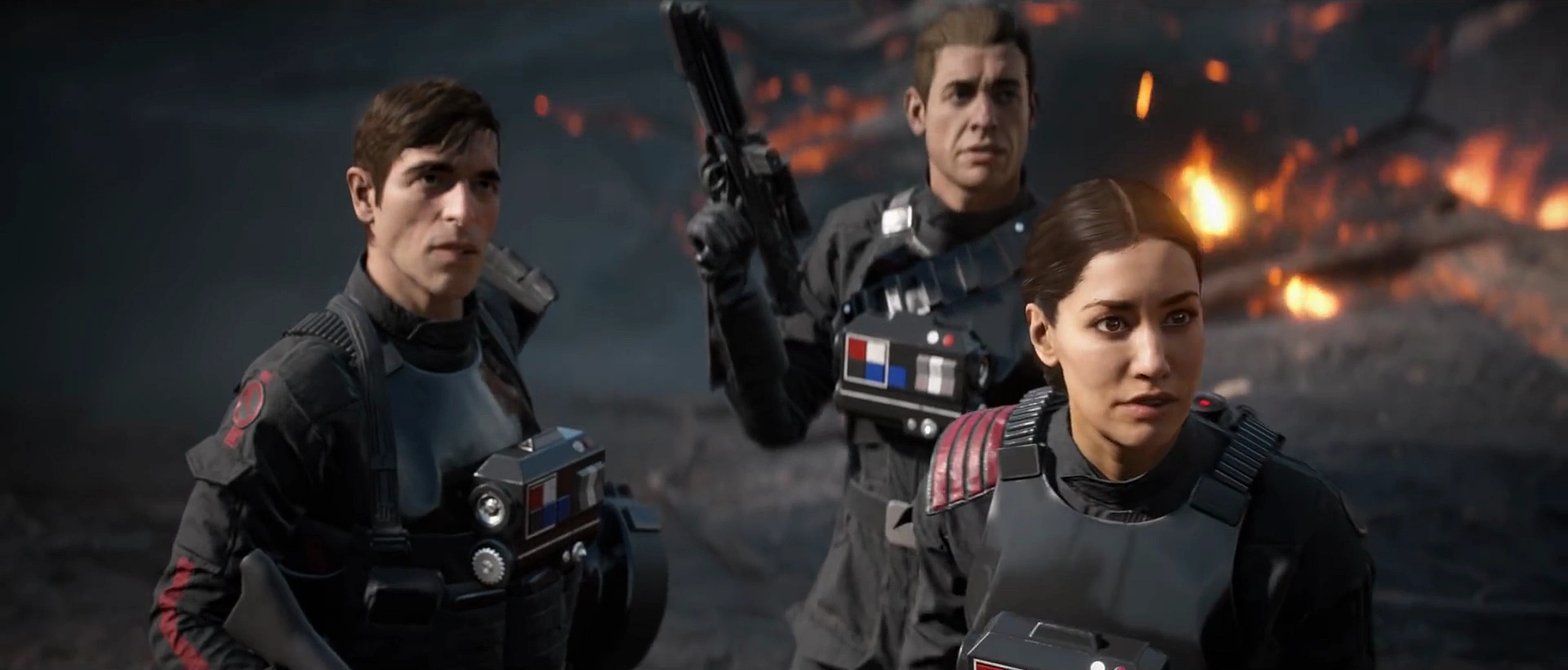 |
| Inferno Squad witnesses the Death Star's destruction from Endor. Image from Wookieepedia. |
Battlefront II was subject to controversy over the system of paying real money for weapons and goodies in-game, but as someone who doesn't play these games, I never got involved.
Twilight Company offered us readers a new perspective on the wars depicted in Star Wars. The heroes of the Star Wars movies are Jedi Knights and pilots, and most of the armies we see are faceless stormtroopers or identical clones. Aside from occasional shots of Rebel troopers in the trenches on Hoth in The Empire Strikes Back, we didn't see much of the Rebel infantry. But we know the Rebels must have taken and held planets, even temporarily, as some worlds directly supported Rebel efforts. Twilight Company lets us see the Galactic Civil War from the perspective of Rebel troopers as they fight the Imperial Army and stormtroopers on a variety of worlds. We also get glimpses of the daily life of a stormtrooper or the Imperial leaders hunting Chalis and the team that took her in. And unlike in the Battlefront game, these troopers are all named, and many given backstories. We're reminded that while the stormtroopers are meant to be anonymous cogs in the war machine, Rebel soldiers are people fighting for a cause. Still, everyone on the story is a side character and their impact to the overall saga is very small.
Inferno Squad permitted us to get a good luck at the motivations of Iden Versio, Del Meeko, and Gideon Hask, the three main characters of the game. This is a story where all of the point-of-view characters are pro-Empire, and for reasons that seem to make sense, but permit the change of heart that some will have down the line.
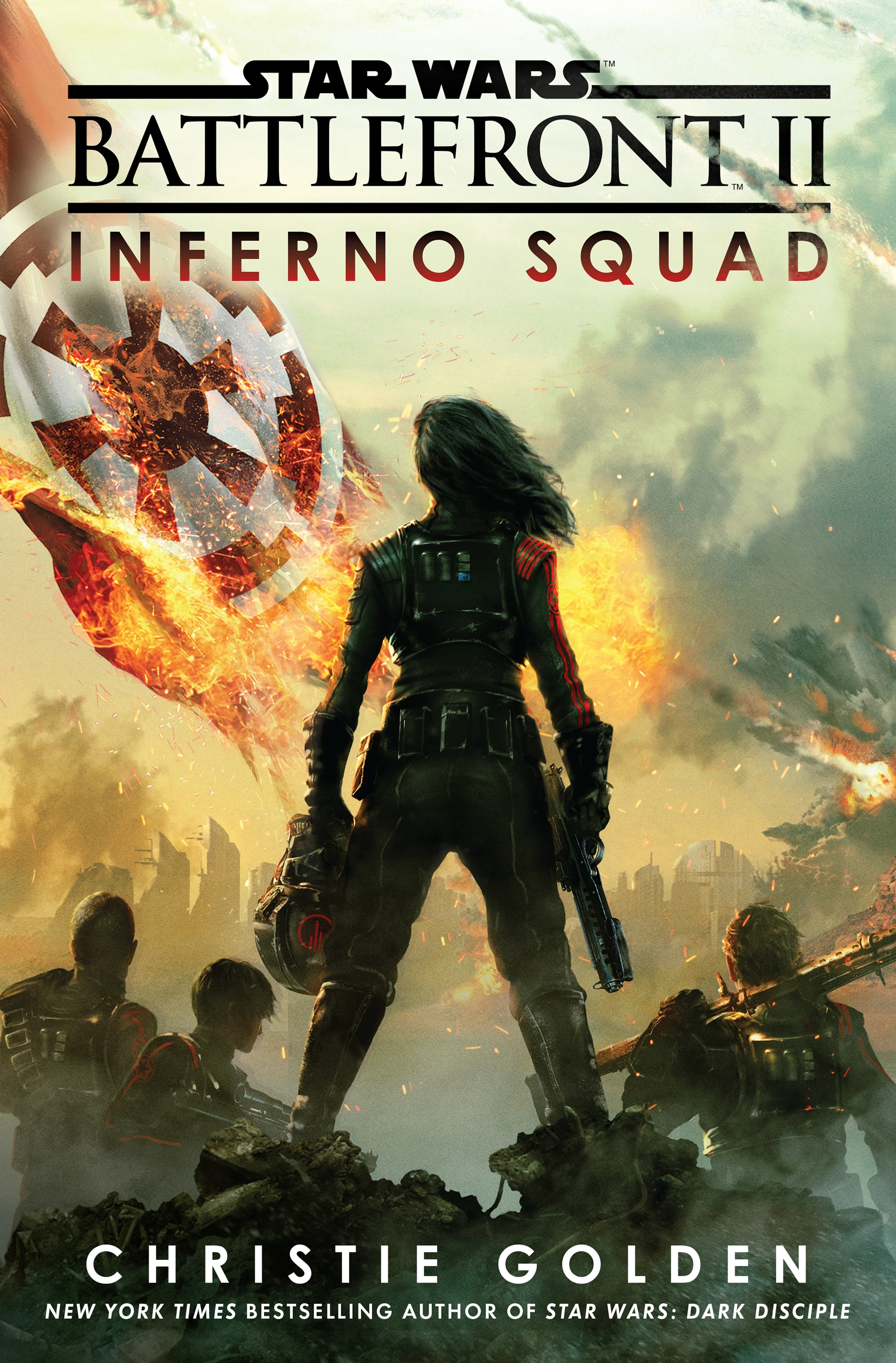 |
| Cover of Battlefront II: Inferno Squad by Christie Golden. Image from Wookieepedia. |
I think of the Battlefront II story as a love story to the rest of the post-Return of the Jedi expanded universe. The story itself is quite compelling, and consistent with the depictions of the Empire between the Battle of Endor and the Battle of Jakku, where many reasonable people switch sides, while those who stick with the Empire are portrayed (quite logically) as either zealots or permitting their honour to take them too far down the wrong path. The game is filled with references to other works, including Aftermath: Life Debt (the Han Solo level is set before he goes to help free the Wookiees), Aftermath: Empire's End (the Battle of Jakku, except from Iden's point of view), Lost Stars (reference to that book's protagonist in the dialogue on Jakku), and the Shattered Empire comic (Iden and Del help Leia free Naboo from the Empire and Operation: Cinder). The compass Luke finds in the Emperor's storehouse on Pillio can be seen among his possessions in The Last Jedi, and the schematics of the Dreadnought retrieved by Iden and Zay in the DLC are used by Poe Dameron to destroy one such ship in The Last Jedi's first act.
Battlefront II also illustrates exactly how well video games are becoming proper performance art. Real actors had their faces and performances captured for the game. Iden Versio was played by actress/model Janina Gavankar, and every aspect of her acting was recreated in the game's engine perfectly. And unlike live action movies, where even slightly incorrect digital faces are noticeable, they fit right in when the entire world is artificially generated. I look forward to seeing the future of video game storytelling.
 |
| Iden Versio from Battlefront II promotional art (left), and actress Janina Gavankar (right). Image from Muscleandfitness.com |
Next:
Follow @C_Andrew_H
Comments
Post a Comment